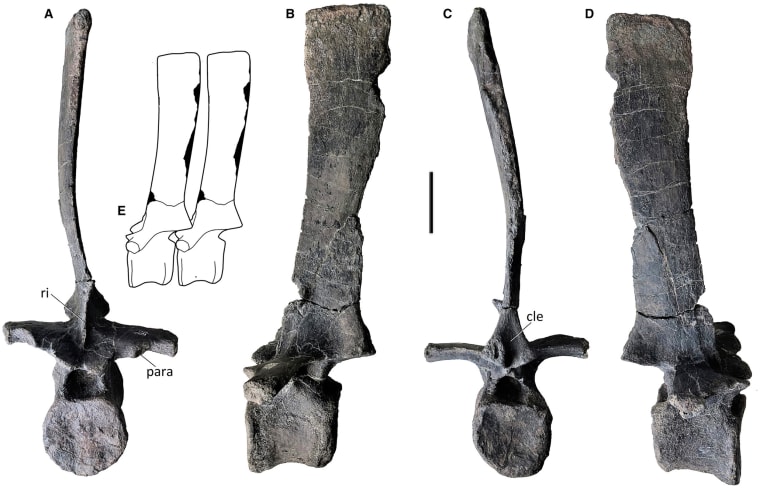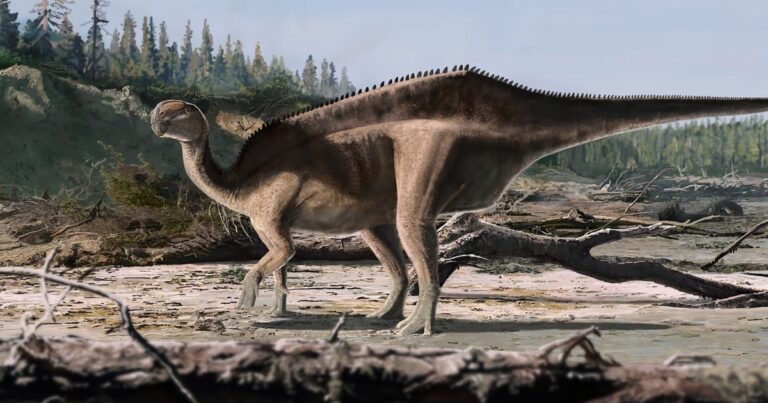LONDON — A former PhD student analyzing 125-million-year-old fossils has made waves with the discovery of a new species of dinosaur that had a sail on its back.
The findings, published in the journal Papers in Palaeontology on Friday, relate to fossils originally excavated in the 1970s on the Isle of Wight, a small island off England’s south coast.
The fossil bones were originally thought to belong to one of the two known species of iguanodontian from the island. But Jeremy Lockwood, a retired doctor, said he noticed unusual differences in the spinal structure of the fossils during his PhD studies in Palaeobiology at the University of Portsmouth, on England’s south coast.
Lockwood, well-versed in anatomy from his medical background, spotted that the dinosaur had an unusually tall neural spine, a protrusion coming from the back.
After carefully re-examining numerous bones held in the collections at the Dinosaur Isle Museum on the Isle of Wight, as well as reviewing published papers, he established that it was a different species altogether.
Although the skeleton wasn’t as complete as some others, the bones hadn’t been closely examined before, Lockwood said in a statement sent by the Natural History Museum in London.

“It was a nice surprise,” Lockwood told NBC News in a phone interview Friday. “We’ve stumbled upon the fact that dinosaur diversity 125 million years ago was much greater than we thought.”
The specific function of a sail in dinosaurs has long been debated, with theories ranging from temperature regulation to fat storage.
Several other dinosaur species also have sails.
In the case of this new species, “the most likely explanation of a sail is visual signaling, possibly as part of a sexual display, which is often driven by sexual selection, ” Lockwood said.
“For me the fun is naming the dinosaur, Lockwood added. “It’s a nice feeling and reward enough logging it into zoobank,” he said, referring to the official online registry for naming animals.
Lockwood, the lead author of the paper, named the new dinosaur Istiorachis macarthurae. Istiorachis means ‘sail spine’ in Ancient Greek, referencing the tall, sail-like structure along the creature’s back.
Macarthurae honors Dame Ellen MacArthur, a famous Isle of Wight resident and sailor, who in 2005 set a world record for the fastest solo non-stop voyage around the world.
“It is certainly not an everyday occurrence to be asked if a newly discovered dinosaur could be named after you!” MacArthur said in a statement.
“I was somewhat taken aback when this conversation began, but felt hugely privileged to be asked.”
“It is both extraordinary and a huge honor that a creature living 125 million years ago could possibly be linked to my family name,” MacArthur added.
“The fact that the Istiorachis ‘sail’ could be comparable to the sails I have spent so much of my life below was very touching.”
“125 million years ago, this dinosaur was also a resident of the island,” Lockwood said. “I like to name dinosaurs in a way that connects to the Isle of Wight, because it’s such an important place paleontologically.”
The new species is not particularly large by dinosaur standards and is similar in size to the American bison, according to the .
This new discovery is just the latest on the island, with 10 new dinosaur species found on the Isle of Wight over the past six years, according to Lockwood.

